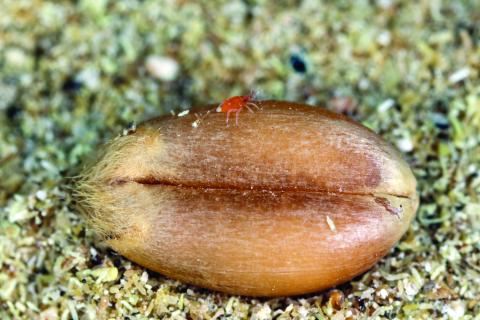The mites are pale, pearly, or greyish-white in colour and their legs vary from pale yellow to reddish-brown, with a claw on each. An interesting characteristic is that in their first larval stage they have six legs but following a moult into the nymphal stage they have eight, like the adult. Mature male grain mites measure 0.33-0.43mm in length; females are larger and can measure up to 0.66mm. To move between food sources the juvenilemite can also change into another distinct form known as a hypopus. In this stage the body hardens and develops suckers, allowing it to attach itself to insects
and other animals.
Dependent on temperature and humidity, the lifecycle can vary from nine to twenty-eight days and a female mite can lay up to 800 eggs. This means populations can rapidly increase into a large infestation, which can appear like a covering of creamy-grey moving dust. A distinctive, musty odour is also evident when infestations are heavy.
Infestations may be hard to spot initially as the mites are most active just below the surface of the stored feed. In this case, heat may be the first indicator that they are present.
In terms of losses in feed value, mite-infested cereals and forages can still be safely fed, but heating is a sign of energy loss. The heat and moisture produced may also provide a favourable environment for secondary spoilage from yeasts and moulds. Timely treatment is therefore advised.
The most effective treatment is to disturb the surface of the stored crop to expose the mite population and dust with Diature (food-grade diatomaceous earth). This consists of fossilised exoskeletons of microscopic organisms called diatoms. The sharp edges kill the mites by lacerating their soft outer shell and dehydrating them. The treatment should be repeated daily untilmite activity has ceased.
If you think your crop was infested with mites last year, then the risk of re-infestation can be reduced by steam cleaning or pressurewashing the stores. It is also recommended to seek advice from your agronomist to discuss treatment with Actellic 50 EC or a similar suitable insecticide. Surfaces can also be dusted with Diature at time of filling. Mites can also live in bales so extra care should be taken if straw or hay is used to weight the clamp.
If you have had issues with mites in the past or you are concerned your feed might be at risk, please speak to your local representative (https://kelvincave.com/).
Access the original article as it appeared in Kelvin Cave's KnowHow Newsletter in summer 2022 below.



